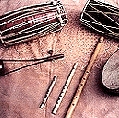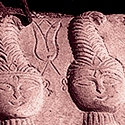
Phulkari and Bagh Embroidery of Punjab
Phulkari- literally embroidered flowers phul = flower; karai= embroidery/embroider) – is the traditional art of crafting embroidered odhnis (head-drape[s] or chaddar (wraps/shawl[s]) used by women in the Punjab. Throughout the Punjab, in the Hindu, Muslim and Sikh communities alike, women embroidered the odhni or chaddar ornamented with phulkari and bagh, garden, a variation where the embroidery completely covers the base material. Using a basic darn stitch used to embroider from the reverse side of the fabric, with the longer float on the face, thus allowing large surfaces to be densely embroidered, the women of the Punjab lovingly and painstakingly embroidered (and continue to embroider) phulkaris- drapes that were and are not only beautiful and colourful but also linked integrally with events considered to be milestones in a woman’s life. The phulkari was and is thus more that just an item of clothing; it is part of an ethos steeped in social and ritualistic traditions. In this respect, it is critical to note at the outset that every embroidered head-cloth or drape is not a phulkari; only those in which the embroidery is done using the darn stitch is known as a phulkari.
It is difficult to date the beginning of the folk art of creating phulkaris. However there is the presence of references to embroidery work in the Punjab as far back as 2,000 years ago: in the Rig Veda, a critical text in the corpus of Vedic literature, as well as in other ancient scriptures where it was termed kashidakariThe term phulkari’ can also be traced to the well-known folk tale of Heer-Ranjha. This tale is ascribed to the poet Waris Shah, whose ancestors had migrated to India form Iran. (In Iran, the word was gulkari- bothgul’ and phul’ mean flower, but Waris Shah used the term only with reference to embroidery). It seems that the craft recognisable as contemporaryphulkari work became visible during the reign of Maharaja Ranjit Singh, a time of peace and prosperity for the people of the Punjab. A settled life, allowing for leisure time was critical to the embroidering of phulkarisas the embroidering could be done only after the women had completed household chores. The women gathered during their leisure hours, usually in the afternoons, to socialise with each other: chatter, news, banter and laughter flowed while deft fingers embroidered motifs and patterns in darn stitches with pat (silk) threads – the phulkari in the making. It is thus that little girls learnt from their mothers and grandmothers, and thus that the craft tradition continued, remaining for a long time, an extremely personal and feminine folk art.
The entire craft of phulkari embroidery and the embroidered drapes known as phulkaris are linked intimately with the rituals and events in a woman’s life in the Punjab. By the first quarter of the nineteenth century the phulkaridrape began to be made and used by the women in the Punjab as a clothing of adornment: not merely for regular wear, but specifically for ceremonial occasions. Mothers and grandmothers embroidered phulkaris for the trousseau(s) of their daughter(s) and grand-daughter(s). Every girl’s dowry included phulkaris; the draping of specially embroidered phulkaris was an integral part of marriage rituals; phulkaris were used by women to mark and celebrate childbirth; and a woman who died as a suhagan- a married woman with her husband still alive, a much-coveted situation – was draped on her funeral pyre in a phulkari. The phulkari was thus a splendid if silent witness to every event considered to be celebratory in a woman’s life: it is no wonder that its making blended love and laughter with detail with dexterity, and that flowers, color and joy were woven in with innovation, art and beauty. The fabric used us usually khaddar, a heavy cotton that is locally woven in narrow widths of 45 to 60 cm joined either before or after the embroidery to form the desired size. The base fabric is most often an auspicious dark brick red, or more rarely, an indigo blue, on which the embroidery is executed in untwisted floss silk called pat, sourced from Kashmir, Afghanistan and Bengal and dyed yellow, orange, burgundy, bright pink, purple, blue and green in Amritsar and Jammu.
Now embroidered across the districts of Punjab from Amritsar district to Jalandhar district, Ferozepur to, Bhathinda Moga, and to Patiala town and Tipari village . The product range has expanded to include Garments and home furnishings.

